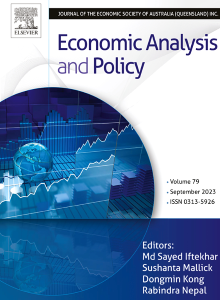The impact of FDI on the development of China's low-carbon economy in the context of the “Dual Circulation” policy
IF 7.9
2区 经济学
Q1 ECONOMICS
引用次数: 0
Abstract
Currently, China's open economy is evolving within the framework of the “Dual Circulation” policy, which emphasizes the “inner circulation” while ensuring that both the “inner circulation” and “external circulation” support each other. In this context, foreign direct investment (FDI) serves as a critical link between domestic and international markets, acting as a natural facilitator of the “Dual Circulation.” Additionally, FDI is a vital tool for achieving the “double carbon” goals, significantly contributing to increased carbon productivity and facilitating the transition to a green economy. This paper examines the impact of FDI on developing China's low-carbon economy using panel data from 30 Chinese provinces between 2010 and 2021. The study tests the spatial autocorrelation of carbon productivity growth in each province using Moran's I and constructs a Spatial Durbin Model (SDM) to test the direct impact and spatial spillover effect of FDI policy. The results indicate that: (1) FDI has a significant spatial spillover effect on China's low-carbon economy. (2) FDI can significantly promote the development of a low-carbon economy in this province and inhibit the development of a low-carbon economy in neighboring provinces. (3) The heterogeneity analysis shows that FDI significantly promotes the development of a low-carbon economy in the eastern and central regions, while significantly inhibiting the development of a low-carbon economy in the western regions. (4) Analyses of spatial mediation effects show that FDI promotes low-carbon economic development by enhancing technological effects. The paper's findings offer valuable insights into the effectiveness of FDI attraction and low-carbon economic development policies in China.
求助全文
约1分钟内获得全文
求助全文
来源期刊

Economic Analysis and Policy
ECONOMICS-
CiteScore
9.80
自引率
9.20%
发文量
231
审稿时长
93 days
期刊介绍:
Economic Analysis and Policy (established 1970) publishes articles from all branches of economics with a particular focus on research, theoretical and applied, which has strong policy relevance. The journal also publishes survey articles and empirical replications on key policy issues. Authors are expected to highlight the main insights in a non-technical introduction and in the conclusion.
 求助内容:
求助内容: 应助结果提醒方式:
应助结果提醒方式:


